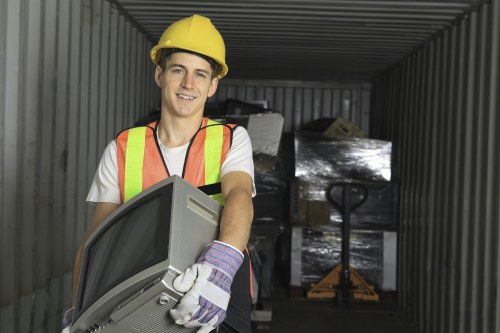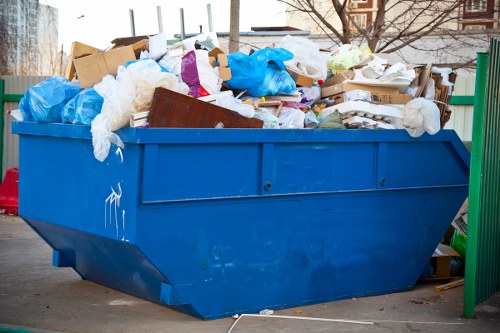Construction Waste Clearance in Hainault
Understanding Construction Waste Clearance

Construction projects, whether large or small, generate a significant amount of waste. Effective construction waste clearance in Hainault is crucial to maintaining a clean and safe environment. Proper waste management not only ensures compliance with local regulations but also promotes sustainability within the construction industry.
Construction waste includes a variety of materials such as concrete, wood, metals, and plastics. Without proper clearance, these materials can pose environmental hazards and create obstacles for new construction activities. Therefore, having a streamlined process for waste clearance is essential for any construction project in Hainault.
Implementing an efficient waste clearance system can lead to numerous benefits, including reduced disposal costs, minimized environmental impact, and enhanced project timelines. By understanding the fundamentals of construction waste clearance, stakeholders can make informed decisions that benefit both their projects and the broader community.
Types of Construction Waste

Construction waste can be categorized into several types, each requiring specific handling and disposal methods. Common types include:
- Concrete and Masonry: These materials are often recycled to be reused in new construction projects.
- Wood: Treated and untreated wood can be repurposed or disposed of safely depending on its condition.
- Metals: Metals like steel and aluminum are highly recyclable and have significant resale value.
- Plastics: Different types of plastics need to be sorted and processed according to their recyclability.
- Glass: Glass waste can be recycled but must be free from contaminants.
Proper classification and handling of these materials are vital to ensure efficient waste clearance and recycling processes.
By categorizing construction waste, companies can optimize their waste management strategies, reduce landfill usage, and promote a circular economy within the construction sector in Hainault.
Importance of Proper Waste Clearance

Proper construction waste clearance plays a pivotal role in maintaining environmental integrity and public health. Neglecting waste management can lead to pollution, legal penalties, and adverse effects on the community.
Ensuring efficient waste clearance helps in reducing the carbon footprint of construction activities. Recycling and reusing materials significantly lower the demand for new raw materials, thereby conserving natural resources and reducing energy consumption.
In addition, proper waste management practices foster a positive image for construction companies, highlighting their commitment to sustainability and responsible business operations. This can lead to increased trust and preference among clients and stakeholders.
Environmental Benefits
Effective waste clearance contributes to numerous environmental benefits, including:
- Reduction in Landfill Use: By recycling and repurposing materials, the reliance on landfills is minimized, preserving these spaces for legitimate waste deposits.
- Lower Greenhouse Gas Emissions: Recycling materials such as metals and plastics reduces the need for energy-intensive production processes, thereby cutting greenhouse gas emissions.
- Conservation of Resources: Reusing materials conserves essential natural resources, ensuring their availability for future generations.
- Prevention of Soil and Water Contamination: Proper disposal prevents hazardous materials from leaching into the soil and water sources, safeguarding ecosystems.
Emphasizing these environmental benefits in construction waste management strategies is essential for sustainable development in Hainault.
By adhering to eco-friendly waste clearance practices, construction projects can significantly reduce their ecological footprint and contribute to a healthier environment.
The Construction Waste Clearance Process

Understanding the systematic process of construction waste clearance in Hainault is key to achieving efficiency and compliance. The process typically involves several critical steps:
1. Planning and Assessment: Before commencing the project, it's essential to assess the types and volumes of waste expected. This helps in formulating an effective waste management plan tailored to the project's needs.
2. Segregation: Waste materials should be segregated at the source to facilitate recycling and reduce disposal costs. Different categories of waste require different handling procedures.
3. Collection and Transportation: Once segregated, waste materials are collected and transported to designated facilities. Efficient transportation logistics ensure timely clearance and minimize disruption to the construction timeline.
Recycling and Disposal
After collection, the next step involves recycling and proper disposal of construction waste.
- Recycling: Recyclable materials such as metals, plastics, and glass are processed and reused in new construction projects or other industries.
- Disposal: Non-recyclable waste is disposed of in compliance with local regulations to prevent environmental contamination.
- Hazardous Waste Management: Special handling is required for hazardous materials to ensure they do not pose risks to human health or the environment.
Employing sustainable recycling practices not only benefits the environment but also can lead to cost savings through the reuse of materials and reduced disposal fees.
Adhering to these processes ensures that construction waste clearance is handled efficiently, responsibly, and in accordance with Hainault's environmental standards.
Choosing the Right Waste Clearance Service

Selecting a reliable construction waste clearance service in Hainault is vital for the success of any construction project. Here are key considerations to keep in mind:
1. Experience and Expertise: Opt for services with a proven track record in handling diverse types of construction waste. Their expertise ensures effective and compliant waste management.
2. Range of Services: Comprehensive services that include waste collection, sorting, recycling, and disposal are preferable. This streamlines the clearance process and reduces the need for multiple contractors.
3. Compliance with Regulations: Ensure that the service provider adheres to local and national waste management regulations. This helps in avoiding legal issues and guarantees environmentally responsible practices.
Key Considerations
When evaluating waste clearance services, consider the following factors:
- Pricing: Transparent and competitive pricing ensures that waste management fits within the project budget.
- Availability: Services that can accommodate the project timeline prevent delays and ensure timely waste clearance.
- Recycling Capabilities: Services that prioritize recycling contribute to sustainability and can offer additional cost savings through material reuse.
- Customer Support: Responsive and supportive customer service facilitates smooth coordination and problem resolution.
By carefully assessing these factors, construction companies can select a waste clearance service that aligns with their project requirements and sustainability goals.
Choosing the right service provider is a strategic decision that can enhance the efficiency and environmental responsibility of construction projects in Hainault.
Benefits of Professional Waste Clearance in Hainault

Engaging professional construction waste clearance services in Hainault offers numerous advantages that contribute to the overall success of construction projects.
Professional services bring expertise and efficiency, ensuring that waste is managed effectively from the outset. This reduces the likelihood of project delays caused by waste accumulation and disposal issues.
Additionally, professional clearance services are well-versed in sustainable practices, promoting the recycling and responsible disposal of materials, which aligns with environmental objectives and regulatory requirements.
Efficiency and Timeliness
One of the primary benefits of professional waste clearance is the enhanced efficiency of the waste management process. Experts can quickly assess waste volumes, implement effective sorting strategies, and ensure timely removal.
- Minimized Downtime: Efficient waste clearance prevents construction site congestion, allowing work to proceed smoothly without interruptions.
- Optimized Resource Allocation: Professionals handle the logistics, enabling construction teams to focus on their core activities.
- Improved Site Safety: Effective waste management reduces hazards associated with cluttered and unsanitary construction sites.
Timely waste clearance is essential for maintaining project schedules and ensuring that construction activities progress without unnecessary delays.
By entrusting waste management to professionals, construction projects benefit from streamlined operations and enhanced productivity.
Sustainability in Construction Waste Management

Sustainability is at the forefront of modern construction practices. Implementing eco-friendly waste management strategies is essential for promoting environmental stewardship and corporate responsibility.
Construction waste clearance in Hainault that prioritizes recycling and resource conservation contributes to a sustainable construction industry. By reducing reliance on landfills and minimizing waste generation, construction companies can significantly lower their environmental impact.
Moreover, sustainable waste management practices can lead to long-term cost savings through the efficient use of materials and reduced disposal fees.
Recycling Initiatives
Recycling is a cornerstone of sustainable waste management. In Hainault, construction companies are increasingly adopting recycling initiatives to repurpose materials and reduce waste.
- Metal Recycling: Metals like steel and aluminum can be melted down and reused, conserving valuable resources and reducing the need for new metal production.
- Concrete Recycling: Crushed concrete can be used as a base material for new construction projects, eliminating the need for fresh aggregate.
- Wood Recycling: Reclaimed wood can be repurposed for various applications, from structural elements to decorative finishes.
- Plastic Recycling: Recycling plastics used in construction can lead to the creation of new products, reducing plastic waste in landfills.
These recycling initiatives not only support environmental goals but also enhance the sustainability profile of construction projects.
By integrating recycling into their waste management plans, construction companies contribute to a circular economy that values resource conservation and waste reduction.
Common Challenges in Waste Clearance

Despite the benefits of effective waste clearance, several challenges can impede the process. Understanding these obstacles is crucial for developing strategies to overcome them.
One significant challenge is managing large volumes of waste generated by extensive construction projects. Efficiently handling and disposing of substantial quantities of waste requires robust logistics and adequate resources.
Another challenge is ensuring compliance with stringent environmental regulations. Navigating the complexities of waste disposal laws necessitates expertise and vigilance to avoid legal penalties and ensure sustainable practices.
Managing Large Volumes
Large-scale construction projects produce vast amounts of waste, which can strain existing waste management systems. Effective strategies to manage these volumes include:
- Advanced Planning: Anticipating waste volumes allows for better resource allocation and scheduling of waste clearance activities.
- On-Site Sorting: Implementing sorting systems on-site can reduce the volume of waste requiring disposal and enhance recycling rates.
- Scalable Waste Solutions: Partnering with waste clearance services that can scale their operations to match project demands ensures efficient waste management.
Addressing the challenge of large waste volumes requires proactive measures and collaboration with experienced waste clearance providers.
By effectively managing high volumes of construction waste, projects can maintain momentum and minimize disruptions caused by waste accumulation.
Future Trends in Construction Waste Clearance

The landscape of construction waste clearance is evolving, driven by technological advancements and increasing emphasis on sustainability. Staying abreast of these trends is essential for construction companies aiming to enhance their waste management practices.
Future trends in construction waste clearance in Hainault include the integration of innovative technologies and the adoption of more sustainable practices.
Technological Advancements
Emerging technologies are revolutionizing how construction waste is managed. Key advancements include:
- Automated Sorting Systems: Robotics and AI-driven sorting systems improve the accuracy and speed of waste categorization, enhancing recycling efficiency.
- Waste Tracking Software: Advanced software solutions allow for real-time tracking of waste streams, facilitating better management and reporting.
- 3D Printing with Recycled Materials: Utilizing recycled materials in 3D printing opens new avenues for sustainable construction practices.
These technological innovations enable more efficient and effective waste management, ultimately supporting sustainable construction goals.
Incorporating such technologies into waste clearance processes can lead to significant improvements in both environmental impact and operational efficiency.
Increasing Sustainability Practices
As environmental concerns continue to grow, sustainability practices in construction waste clearance are becoming increasingly important. Key practices include:
- Zero Waste Goals: Striving for zero waste by maximizing recycling and minimizing waste generation.
- Green Building Certifications: Achieving certifications like LEED requires adherence to stringent waste management standards.
- Community Engagement: Involving the local community in sustainability initiatives fosters a collective effort towards environmental stewardship.
These practices not only contribute to environmental sustainability but also enhance the reputation and marketability of construction projects.
By embracing these sustainability trends, construction companies can lead the way in responsible and eco-friendly waste management.
Conclusion
Effective construction waste clearance in Hainault is integral to the success and sustainability of construction projects. By understanding the types of waste, importance of proper clearance, and the comprehensive processes involved, stakeholders can ensure that their projects are environmentally responsible and compliant with regulations.
Choosing the right waste clearance service, embracing sustainability practices, and staying informed about future trends further enhances the efficiency and impact of waste management efforts.
Contact us today to learn more about our professional construction waste clearance services in Hainault and how we can help you achieve a cleaner, more sustainable construction process.